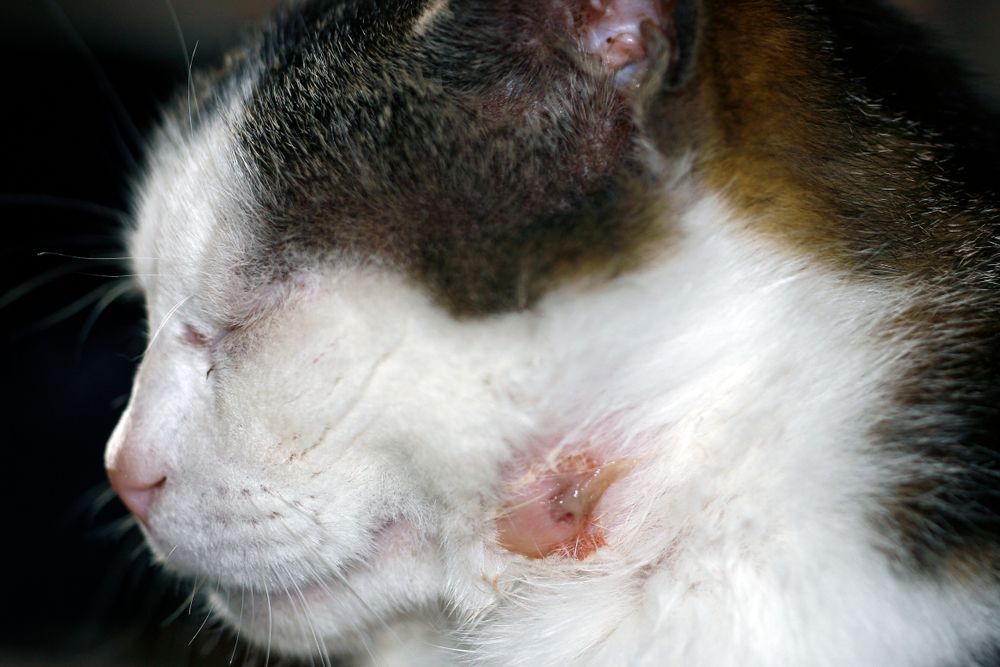
Shutterstock.com
Bot fly in cats describes when a cat is infected with the worm-like larva of the Cuterebra fly. In this article, you’ll learn what cuterebriasis is in cats, how to recognize it, treatment options, and some frequently asked questions.
What Is Bot Fly in Cats?
Bot fly in cats is also called cuterebriasis. This is a condition caused by the bot fly Cuterebra. The Cutebebra bot fly more often causes disease in rabbits or rodents, but a cat may become an accidental host.
Unlike other types of fly maggot infestations, where flies lay eggs directly on a host animal, the large Cuterebra fly is not directly involved with this disease condition in pets.
The adult fly lays eggs on vegetation near the burrows or nests of rabbits and other small rodents.
Cats can acquire a bot fly infestation when they investigate animal burrows or nests. The eggs hatch in response to an increase in outdoor temperature. When they hatch, the tiny larvae can attach to the fur of a passing animal and then migrate into the body through either the nose or mouth.
Cuterebriasis in cats most often occurs in the late summer or early fall. In very temperate areas, this condition may occur year-round.
Bot fly larvae may also migrate into open wounds. But unlike many other fly maggots, Cuterebra larvae cannot directly enter unbroken skin.
Once inside the body, the Cuterebra larvae will most often migrate to an area just under the skin. When this happens a small lump forms on the skin, which is called a warble. The warble will have an opening hole or fistula so that the larval worm can breathe air.
After about 30 days, the Cuterebra larval worm will exit the skin through this breathing hole, fall to the ground, and burrow into the soil. The larva will then go through another phase called pupation. The bot fly will remain as a pupa for months or even years. But eventually, the adult fly will emerge from the soil.
Causes of Bot Fly in Cats
Cats can only acquire a bot fly infection by coming in contact with the newly hatched larva from eggs laid by an adult Cuterebra fly. This is usually on leaves, grass, or other vegetation near a rabbit or rodent burrow.
As skilled hunters, cats may investigate these burrows or nests. When they brush by an area where newly hatched bot fly larvae are located, the larvae can attach to the fur.
Symptoms of Bot Fly in Cats
The most common symptom to look for is the warble, through which the Cuterebra larva breathes. You can actually see the larva itself through the warble hole, or fistula, as it comes up every few seconds to breathe air.
The warble may be located anywhere under the skin, but the most common locations include the head, neck, and shoulders. Warbles themselves are not always painful but secondary infections and swelling in the area may cause discomfort.
Other clinical signs you may see in cats include:
- Your cat is excessively licking or scratching at one small area around the head or neck.
- A focused area of matted fur, especially around the head or neck.
- Pus may be seen, as the warble may sometimes become infected.
Complications of Having Bot Fly in Cats

Shutterstock.com
While the bot fly larva most often migrates to an area just under the skin, there are cases where the larva may migrate somewhere else, inside the body.
Other areas of the body that Cuterebra larva may migrate to in cats include:
- Eye
- Nasal passages
- Brain
- Spinal Cord
When the Cuterebra migrates to one of these other locations in the body, disease symptoms can be more severe.
Eye (ophthalmomyiasis): the larva may enter the area around the eye and be found under the lid or conjunctival tissues. It may also migrate into the eye itself.
Signs to look for include:
- Red eye
- Swelling beneath or around the eye
- Lots of squinting or blinking
- Pawing at the eye
- Discharge from the eye, especially yellow, white, or green in color
Blindness can result from this form of bot fly in cats but usually only if the larva migrates into the eye itself.
Nasal Passages: this may be a route that the bot fly larva use to enter the body. They may continue on to set up under the skin somewhere else, or they may accidentally remain in the nasal passages.
Signs to look for include:
- Excessive sneezing/uncontrolled sneezing fits
- Nasal discharge, especially yellow, white, or green in color
- Bloody nasal discharge
Neurologic Disease: the bot fly larvae may migrate through the nasal passages and continue through the tissues at the back of the nose into the brain itself. On occasion, they have also been found in the front part of the spinal cord. Migration through open wounds may also lead to larvae reaching the spinal cord.
There are many potential signs that can be seen but the most common may include:
- Vestibular signs (head tilt, walking in circles, sudden issues with balance)
- Seizures
- Head pressing
- Sudden behavioral changes
In many cases of neurologic disease caused by Cuterebra, acute repetitive sneezing or other upper respiratory signs were seen weeks prior. Cuterebra could be suspected in any cat with acute onset of recurrent sneezing/respiratory signs that stop and are then followed by acute onset of neurologic symptoms.
Diagnosis of Bot Fly in Cats
The more common presentation of cuterebriasis in cats where the larva resides within the warble in the skin can be diagnosed visually by a veterinarian. The larva itself can usually be seen coming to the surface of the warble skin hole to breathe every few seconds. Matted fur or debris must sometimes be removed in order to clearly see the warble itself.
Other forms of cuterebriasis may be harder to diagnose. There are other common causes of diseases affecting the eyes, upper respiratory tract, and neurologic system in cats.
There is a blood test called an ELISA test that can detect Cuterebra. However, this test may not show a positive result in cats that have a recent or acute infection. X-rays may identify some non-specific changes caused by Cuterebra migration in the body, but are unlikely to show any signs that can be specifically attributed to the bot fly larva.
If Cuterebra is suspected in the case of disease affecting the eye, sedation may be needed for a veterinarian to get a closer inspection of the tissues under the lid or around the eye itself. If the larva has migrated inside the eye itself, diagnosis may be very difficult. Referral to a veterinary ophthalmologist may assist in reaching a diagnosis sooner.
If Cuterebra larva migration is suspected as a cause of vestibular disease, seizures, or other neurologic disease, a CT or MRI scan may be the only way to diagnose bot fly larva migration as the root cause.
Neurologic symptoms like those discussed occurring in very young cats or kittens would warrant referral to a veterinary neurologist. Other diseases including toxoplasmosis and feline infectious peritonitis (FIP) can have similar neurologic sign appearance. A neurologist may be able to reach a more conclusive diagnosis.
Cuterebra causing respiratory disease may be hard to diagnose as well because symptoms may last for a couple of weeks and then stop if the Cuterebra has completed migration through the nasal passages.
Chronic sneezing or discharge may be investigated with an endoscope where a larva may be seen. Some vets have endoscopy available but often referral to an internal medicine specialist is needed. A CT scan may also help to identify Cuterebra as a cause of nasal disease.
Treatments for Bot Fly in Cats

Shutterstock.com
If a Cuterebra larva is residing in the warble just under the skin, your veterinarian can carefully remove it using forceps. In some cases, this may require sedation, especially if your cat is experiencing any pain or irritation at the warble site.
If the larva is squished or crushed during removal, it may release chemical signals that can cause a bad inflammatory or allergic response in the cat. To reduce this risk prior to removal, a steroid and/or antihistamine (such as diphenhydramine) may be given.
Antibiotics may be prescribed if there is an infection present around the warble site.
Once the larva is gone, the hole in the skin will heal on its own, usually within 2-3 weeks.
If the eye is affected, treatment will depend on where the bot fly larva is located. Larva have been successfully removed from beneath the lid or conjunctival tissue under heavy sedation or anesthesia. If the larva is inside the eye itself, the entire eye may need to be surgically removed.
Neurologic disease caused by cuterebriasis in cats can be very difficult to treat. The disease is often rapidly progressive as the larva continues to migrate and cats can often die from this form of the disease.
If this form of the disease is suspected, treatment has been attempted using ivermectin and steroids. Cats who do recover from this form of the disease may still have some permanent neurologic changes including seizures, walking/balance issues, and behavior/mentation changes.
Prevention of Bot Fly in Cats
The best way to prevent Cuterebra-related disease is to limit a cat’s access to the rabbit and rodent dens and burrows where the adult fly lays its eggs. Indoor cats have almost no risk of acquiring bot fly-related diseases. It may be possible to limit access for indoor/outdoor cats who don’t travel beyond your property if you know where the dens and burrows are.
It may be impossible to limit access to outdoor cats who roam a distance from your property.
There are no preventive products that are approved for the control of Cuterebra bot flies in cats. However, there is evidence that some topical insecticide products may provide some protection, including fipronil (Frontline) and imidacloprid (Advantage II, Advantage Multi, Seresto). Some preventative products in the macrocyclic lactone class (Interceptor, Revolution) may be able to kill early larvae during their migration phase.
Cat Care Tips
If you suspect your cat may be infected with a Cuterebra bot fly larva, here are some important tips:
- Don’t try to squeeze the larva out. While tempting, this is more likely to damage the larva, which can cause a bad allergic reaction in the cat.
- Don’t try treating on your own with ivermectin. Ivermectin is not approved for use in cats and needs careful off-label dosing by a veterinarian for the best safety and outcome.
- If you see a Cuterebra in your cat’s skin, get them to your vet as soon as possible. They can remove the larva safely for you.
Frequently Asked Questions
How do I know if my cat has bot fly?
The larval stage of the Cutereba botfly most often enters the mouth or nose of a cat, then migrates under the skin. It forms a swelling just under the skin called a warble, which has an airhole so the larval worm can breathe. Usually the warble will be found on the head or neck. Finding this hole in the skin with the Cuterebra larva inside confirms the presence of botfly. The larva is usually visible as it comes up every few seconds to breathe.
If the bot fly larva migrates somewhere else in the body like the nasal passages, respiratory tract, eye, or nervous system, the symptoms can appear very similar to other diseases that affect those parts of the body. Your veterinarian may consider Cuterebra if there is a sudden onset of symptoms in one of these regions of the body in a very young cat.
In older cats, it may be very difficult to determine Cuterebra bot fly larva as a cause without advanced diagnostics like endoscopy, CT, or MRI scans.
What happens if a bot fly is not removed from a cat?
If the Cuterebra bot fly larva is in a warble just under the skin, it will eventually leave of its own accord. After about 4-6 weeks, the larva will drop out onto the ground and pupate in the soil until it hatches as an adult fly months or years later.
If the bot fly larva is present elsewhere in the body internally, it can unfortunately cause significant disease as it migrates through body tissues. It may eventually die within that tissue. Depending on where the larva migrates, it can cause permanent damage, especially in the brain or spinal cord.
Will a bot fly leave a cat on its own?
As long as it is present just under the skin, yes. After 4–6 weeks, the Cuterebra bot fly larva will exit through its airhole in the skin and drop onto the ground.
Although it may leave on its own, it is better to have it removed by a veterinarian if discovered. The presence of the bot fly under the skin can be irritating to the cat and its migration through the skin can lead to secondary bacterial infection.
If the bot fly larva has migrated somewhere else in the body internally, it unfortunately is very unlikely to be able to leave on its own.
Is a botfly contagious?
No. Cuterebriasis that is caused by the bot fly larva is not contagious to other animals and poses no public health risk to people. Each cat that develops cuterebriasis is individually affected when they come in contact with the newly hatched larvae that are present near rabbit and rodent burrows/dens.
The bot fly larva itself that is visible within the hole/swelling in the skin is not dangerous. It cannot bite and it cannot burrow through intact skin. It will not exit the hole except to fall out several weeks after it set up under the skin.
-
Bowman, D. Cutebrebriasis in cats (Proceedings). DVM360. April 1, 2009. Accessed September 14, 2023.https://www.dvm360.com/view/cuterebriasis-cats-proceedings
-
Companion Animal Parasite Council. Cuterebriasis. Updated July 28, 2020. Accessed September 14, 2023.https://capcvet.org/guidelines/cuterebriasis/
-
Hunter, T. and Ward, E. Cuterebra or Warbles in Cats. VCA Animal Hospitals. Accessed September 14, 2023.
https://vcahospitals.com/know-your-pet/cuterebra-or-warbles-in-cats
-
James FM, Poma R. Neurological manifestations of feline cuterebriasis. Can Vet J. 2010 Feb;51(2):213-5. PMID: 20436872; PMCID: PMC2808293. Accessed September 14, 2023.
https://www.ncbi.nlm.nih.gov/pmc/articles/PMC2808293/
-
Lundgren, B. Cuterebriasis is a Parasite Causing Skin Infections in Dogs and Cats. Veterinary Partner. Published September 18, 2006. Revised February 18, 2020.
https://veterinarypartner.vin.com/default.aspx?pid=19239&id=4952530
-
Martins, J. Cuterebrosis in Cats - Signs and Symptoms. Belle Mead Animal Hospital. August 15, 2021. Accessed September 14, 2023.
https://www.bellemeadanimalhospital.com/blog/cuterebrosis-in-cats-signs-and-symptoms/
-
Moriello, K.A. Cuterebra Infestation in Dogs and Cats. Merck Veterinary Manual. Reviewed/Revised 2019. Modified October 2022. Accessed September 14, 2023.
-
Scanlin, S., & Michaels, J. R. (2023). Acute onset of circling and dull mentation in a 1-year-old male neutered domestic shorthair cat. Journal of the American Veterinary Medical Association, 261(6), 1-4. Retrieved Sep 21, 2023, from https://doi.org/10.2460/javma.22.10.0465
https://avmajournals.avma.org/view/journals/javma/261/6/javma.22.10.0465.xml
-
Schlesener BN, Peck EA, Teplitz EM, et al. Feline ophthalmomyiasis externa caused by Cuterebra larvae: four cases (2005–2020). Journal of Feline Medicine and Surgery. 2022;24(2):189-197. doi:10.1177/1098612X211013021
https://journals.sagepub.com/doi/full/10.1177/1098612X211013021
-
Starkey, L.A. Cuterebriasis in Dogs and Cats. Today’s Veterinary Practice. Published August 4, 2021. Accessed September 14, 2023.
https://todaysveterinarypractice.com/parasitology/cuterebriasis-in-dogs-and-cats/
-
Thomas, J.E. and Reichard, M.V. Managing Maggots and Bots in Dogs in Cats. Veterinary Team Brief. May 2018. Accessed through Clinician’s Brief, September 14, 2023.
https://www.cliniciansbrief.com/article/managing-maggots-bots-dogs-cats







